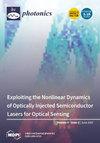Wavelength Dependence of Modal Bandwidth of Multimode Fibers for High Data Rate Transmission and Its Implications
IF 2.1
4区 物理与天体物理
Q2 OPTICS
引用次数: 0
Abstract
Vertical-cavity surface-emitting laser (VCSEL)-based transmission over multimode fiber (MMF) has achieved data rates of 100G per lane and is progressing towards 200G per lane. Recently, high-data-rate MMFs derived from OM3 and OM4 have been proposed. These fibers exhibit higher effective modal bandwidths at 910 nm, leading to a different wavelength dependence compared to conventional OM3 and OM4 MMFs. Understanding the wavelength dependence of these fibers is crucial to address their utilization in a broader range of applications. Through Monte Carlo simulations, we have obtained the low-end boundary of the effective modal bandwidths (EMBs) for these fibers, revealing capability improvements over the existing OM3 and OM4. The high-data-rate OM4 performs the same as or better than OM5 from 840 nm to 920 nm, while also showing a high bandwidth for the 850–870 nm wavelength window, favoring VCSELs with center wavelengths shifted toward 860 nm. We also obtained the link bandwidth, which includes both modal bandwidth and chromatic dispersion contributions, and the transmission reaches for various types of transceivers. We find that for both high-data-rate OM3 and high-data-rate OM4, the link bandwidth stays above the value at 850 nm until around 910 nm, delivering a similar transmission performance from 850 to 910 nm without declining towards longer wavelengths, unlike the standard OM3 and OM4. This characteristic favors a wider range of wavelength choices for VCSELs and enables optimal deployments for various applications.用于高数据速率传输的多模光纤模态带宽的波长依赖性及其影响
基于垂直腔表面发射激光器(VCSEL)的多模光纤(MMF)传输已实现了每通道 100G 的数据传输速率,并正在向每通道 200G 的数据传输速率迈进。最近,人们提出了源自 OM3 和 OM4 的高数据速率 MMF。与传统的 OM3 和 OM4 MMF 相比,这些光纤在 910 nm 处显示出更高的有效模态带宽,从而导致不同的波长依赖性。了解这些光纤的波长依赖性对于将其应用于更广泛的领域至关重要。通过蒙特卡洛模拟,我们获得了这些光纤有效模态带宽(EMB)的低端边界,揭示了与现有 OM3 和 OM4 相比的性能改进。从 840 纳米到 920 纳米,高数据速率 OM4 的性能与 OM5 相同或更好,同时还显示出 850-870 纳米波长窗口的高带宽,有利于中心波长偏移到 860 纳米的 VCSEL。我们还获得了链路带宽(包括模态带宽和色度色散贡献)以及各类收发器的传输距离。我们发现,与标准 OM3 和 OM4 不同,高数据速率 OM3 和高数据速率 OM4 的链路带宽都高于 850 nm 的值,直到 910 nm 左右,从 850 nm 到 910 nm 具有相似的传输性能,而不会向更长波长下降。这一特性为 VCSEL 提供了更广泛的波长选择范围,使各种应用都能得到最佳部署。
本文章由计算机程序翻译,如有差异,请以英文原文为准。
求助全文
约1分钟内获得全文
求助全文
来源期刊

Photonics
Physics and Astronomy-Instrumentation
CiteScore
2.60
自引率
20.80%
发文量
817
审稿时长
8 weeks
期刊介绍:
Photonics (ISSN 2304-6732) aims at a fast turn around time for peer-reviewing manuscripts and producing accepted articles. The online-only and open access nature of the journal will allow for a speedy and wide circulation of your research as well as review articles. We aim at establishing Photonics as a leading venue for publishing high impact fundamental research but also applications of optics and photonics. The journal particularly welcomes both theoretical (simulation) and experimental research. Our aim is to encourage scientists to publish their experimental and theoretical results in as much detail as possible. There is no restriction on the length of the papers. The full experimental details must be provided so that the results can be reproduced. Electronic files and software regarding the full details of the calculation and experimental procedure, if unable to be published in a normal way, can be deposited as supplementary material.
 求助内容:
求助内容: 应助结果提醒方式:
应助结果提醒方式:


